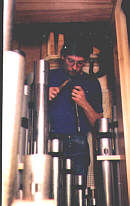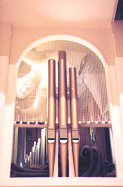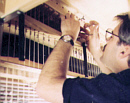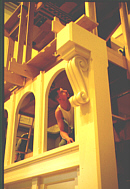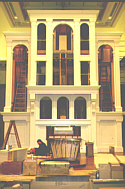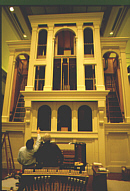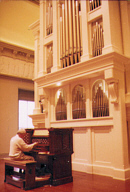
|
|
The most creative (and painstaking)
part of organ building, says master voicer, Michael Shofar,
(pictured above) is crafting each pipe so that it "speaks
right."
|
|
"Try the A just a little bit higher. Just a hair," calls Shofar,
from his seat at the organ's keyboard. High above him on a
catwalk, assistant Don Benninghoff moves among the pipes, making
an adjustment. A moment later Benninghoff scrambles down a ladder
in back and comes around front to hand Shofar a narrow silver
pipe. Shofar blows into the bottom of it, then uses a small poker
to widen the hole in the pipe's base. The two men have been at
this job now for four weeks. "We have to run over each pipe and
make sure each one has the proper speech," Shofar looks up to
explain.
Sutherland drops in on the duo late each afternoon, to talk with
them and to listen to the results of their daily labors.
Sometimes the organist will make a suggestion: "How about taking
the edge off here," or, "Let's make this voice a little broader."
Sutherland, whose artistic pedigree can be traced all the way
back to J.S. Bach, first worked with Shofar back in 1965. He
remains amazed at the voicer's remarkable ability to hear the
subtlest variations in sound. "Mike Shofar is Holtkamp Organs,"
says Sutherland. "He's the one who draws all the sounds
together."
Back out in the hallway, Sutherland talks with excitement about
what the new organ will mean to Peabody. For one thing, it will
make it much easier for him to recruit top organ students. In
recent years the program has averaged about a dozen students; he
expects to see that number increase. For another, it will broaden
the musical experience of everyone at the conservatory. "It means
that Peabody students will be able to hear the great organ works
of Bach, right here," he says. Already, there are composition
students at work on pieces for organ. And he's been approached by
trumpet students and voice students, who've eagerly asked whether
they'll be able to use the organ for ensemble recitals. His
reply? An emphatic, "Of course!"
|



